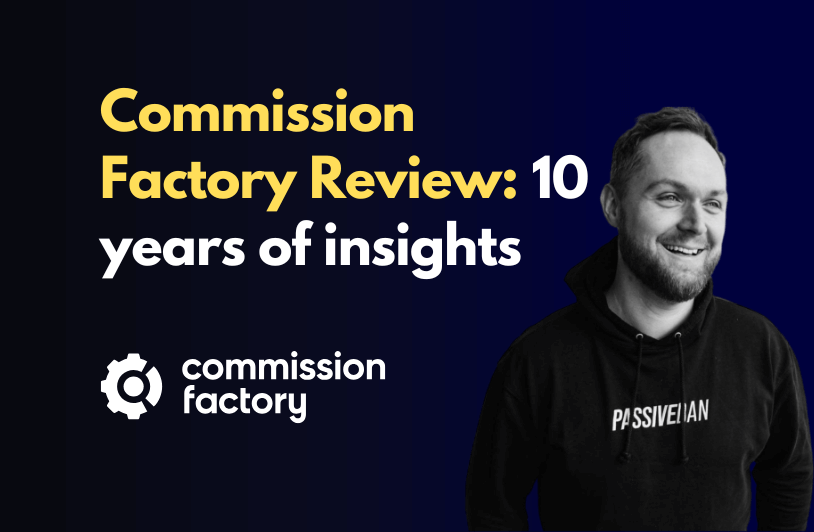This Commission Factory affiliate network review comes from a place of real, hands-on experience—a full decade of it. This was the very first affiliate network I ever joined, and it’s also the platform where I hit my first six-figure year. So yeah, I know it inside and out.
My Decade-Long Journey with Commission Factory
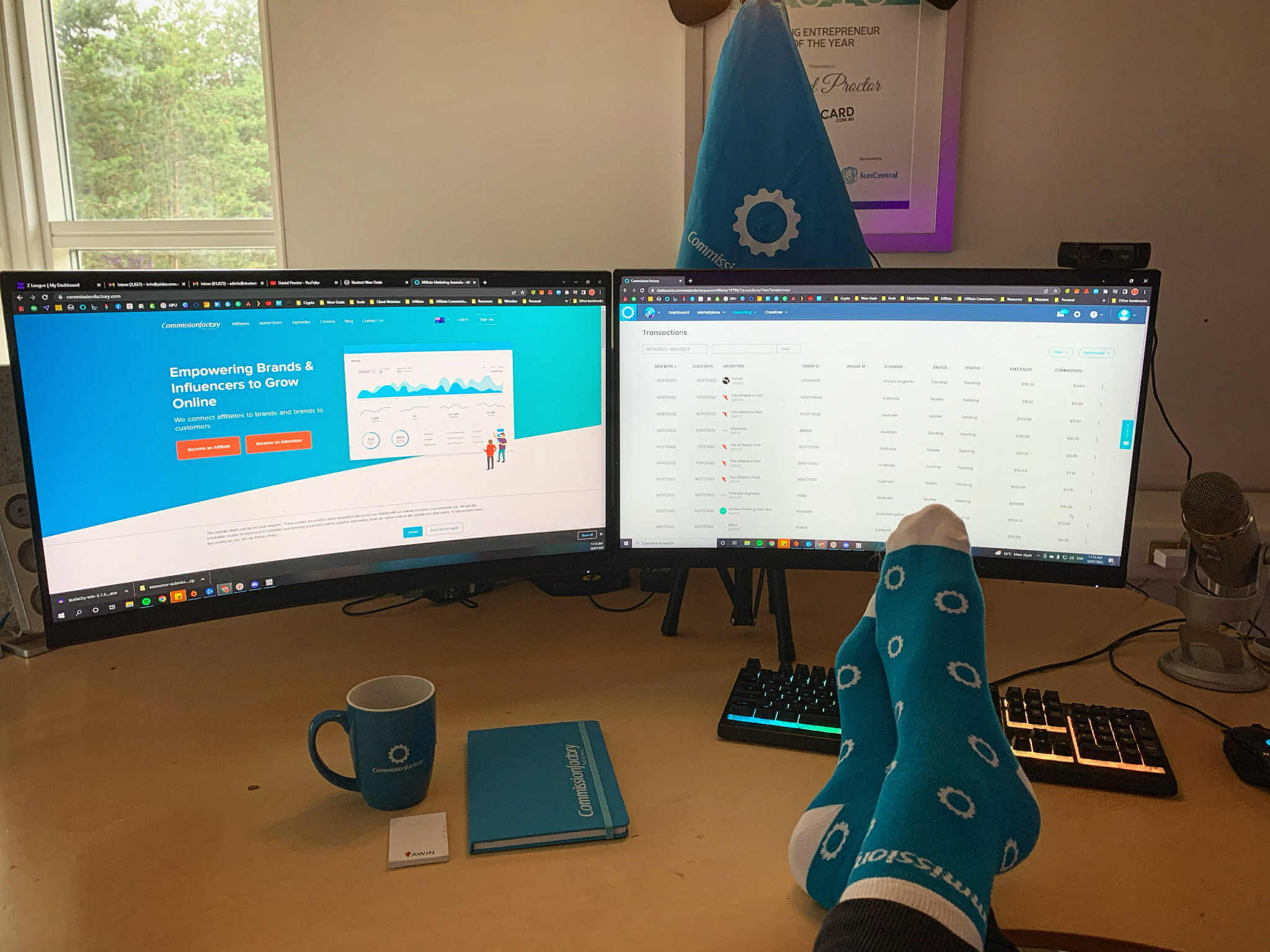
My story with Commission Factory kicked off over 10 years ago. Back then, it was a smaller, start-up company founded on the beautiful Sunshine Coast in Queensland, Australia. As someone just getting my feet wet in affiliate marketing, I was specifically looking for a network that actually got the local market, and their focus on Australian and New Zealand brands was exactly what I needed.
Joining was a huge turning point for me. The platform felt accessible, the support team felt like real people, and the opportunities seemed genuine. I watched the network grow year after year, adding bigger brands and polishing its tech. My own journey mirrored theirs; as Commission Factory grew, so did my income. It was on this network that I learned the ropes, experimented with different strategies, and eventually scaled my business into a consistent six-figure annual income.
From Local Startup to Global Powerhouse
The transformation of Commission Factory has been nothing short of impressive. What began as a focused, regional network slowly but surely became the go-to platform in the Asia-Pacific. That kind of success doesn’t stay quiet for long. Eventually, the global affiliate giant AWIN acquired Commission Factory, merging it into its massive worldwide network.
This was a game-changer. It gave local publishers like me access to huge international brands while letting us keep the user-friendly interface and regional expertise we loved. The acquisition cemented Commission Factory’s place as a top-tier network, offering the best of both worlds: deep local knowledge backed by the power and resources of a global leader.
Getting Approved: What You Need to Succeed
Commission Factory is fantastic, but it’s not really for someone starting with a brand-new website and zero traffic. They’re looking for partners who have already done some of the heavy lifting and are ready to hit the ground running.
To get your foot in the door, you need to look like a professional publisher. Here’s what you should have sorted before you apply:
- A Professional Media Kit: This is your business card and resume all in one. It needs to show off your brand, audience demographics, and traffic stats.
- A Website with Traffic: You need an active website or a solid social media presence that’s already getting eyeballs. This shows them you have an audience to promote to.
- A Clearly Defined Niche: Are you the go-to person for tech reviews, sustainable fashion, or keto recipes? A focused niche is way more appealing to brands than a general “lifestyle” blog.
- High-Quality Content: Your content needs to be well-written, engaging, and genuinely useful. This proves you can represent brands professionally.
If you’re just starting out, focus on building these assets first. Our guide on affiliate marketing for bloggers is a great place to learn how to build that foundation.
Is Commission Factory for beginners? Yes and No. If you have an established blog or social media following, it’s an excellent platform. If you’re starting with zero online presence, you’ll need to build that first before applying.
A Look at the Brands and Tools
The platform is packed with thousands of advertisers, including massive names like Nike, The Body Shop, Shaver Shop, Avis Car Rental, and Nutrition Warehouse. With such a wide variety of partners, you can find opportunities in almost any vertical you can think of.
Like any network, though, it has its quirks. The dashboard is clean and the reporting is solid, but some of the more advanced analytics tools you might find on other global networks feel a bit less developed. Creating links is dead simple, but deep-diving into the data can sometimes take an extra click or two. Even with these minor points, the core features are robust enough for any publisher to manage and grow their campaigns.
What Is Commission Factory and How It Works
Think of Commission Factory as the essential middleman, a massive marketplace connecting brands with affiliate marketers like you and me. Advertisers list their products, and publishers (that’s us) find the right stuff to promote to our audiences. It’s actually where my own affiliate journey kicked off over a decade ago, and it was the first network where I really cracked the code, scaling my efforts into a six-figure annual income.
At its core, the platform takes a complex relationship and makes it simple. Brands want more sales, and you have an audience that trusts what you say. Commission Factory provides all the tech in between—tracked links, reporting dashboards, and payment processing—to make sure the whole partnership is fair and transparent for everyone involved.
This diagram breaks down how retailers, publishers, and the tracking technology all fit together.
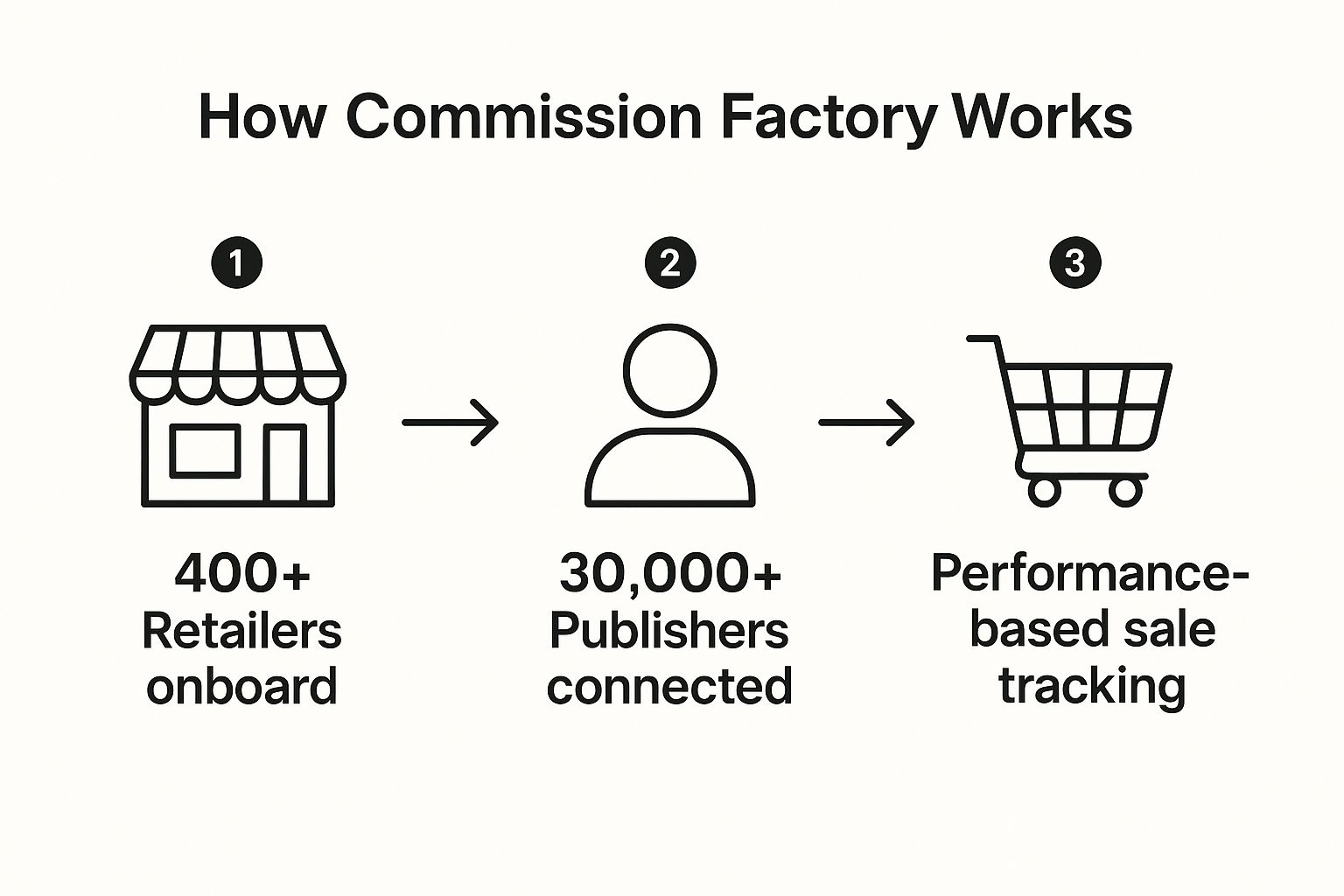
It’s a straightforward, performance-based model: publishers get rewarded for driving actual sales. No fluff. This simple but powerful system is exactly what has fueled the network’s incredible growth over the years.
A Local Startup Turned Global Player
What began on the Sunshine Coast in Queensland, Australia, has since blown up into a dominant force in performance marketing. Founded back in 2011 by a couple of former affiliate marketers, Commission Factory quickly became the go-to network for the Asia-Pacific region, and its global reach is still expanding. Today, it hosts over 400 retailers and more than 30,000 publishers—a pretty impressive scale.
One of its standout features has always been its custom commission settings. Brands can get really granular, tailoring rewards for specific products or sale values to squeeze the most out of their ad spend. You can actually read more about how brands can fine-tune their budgets over on their blog.
This impressive growth didn’t go unnoticed. Eventually, the global affiliate titan AWIN acquired Commission Factory. Honestly, this was a massive win for affiliates. It blended a user-friendly, locally-focused platform with AWIN’s enormous portfolio of international brands.
Strengths and Weaknesses of the Platform
No honest review is complete without looking at the good and the bad. While the platform has some powerful tools, you need to know its limitations before diving in.
Pros:
- User-Friendly Interface: The dashboard is clean and intuitive. It’s genuinely easy to find programs, grab your links, and check your basic reports without getting lost in a sea of menus.
- Strong Local Brand Portfolio: It has an unmatched roster of Australian and Asia-Pacific brands. We’re talking giants like Nike and The Body Shop alongside popular retailers like Shaver Shop and Nutrition Warehouse.
- Reliable Payments: With a low payout threshold and a consistent payment schedule, you can actually count on getting your commissions on time, every time.
Cons:
- Advanced Analytics Could Be Stronger: The reporting is perfectly fine for day-to-day tracking. But if you’re looking for the kind of deep-dive analytics you find in some of the bigger global networks, you might find it a bit basic.
- API Can Be Limited for Developers: For affiliates who like to build their own custom tools, the API documentation and functionality can feel less robust compared to some of the competition.
Despite these minor drawbacks, the platform’s core strengths make it an excellent choice, especially if you’re targeting an audience in the APAC region.
Navigating the Platform and Affiliate Tools
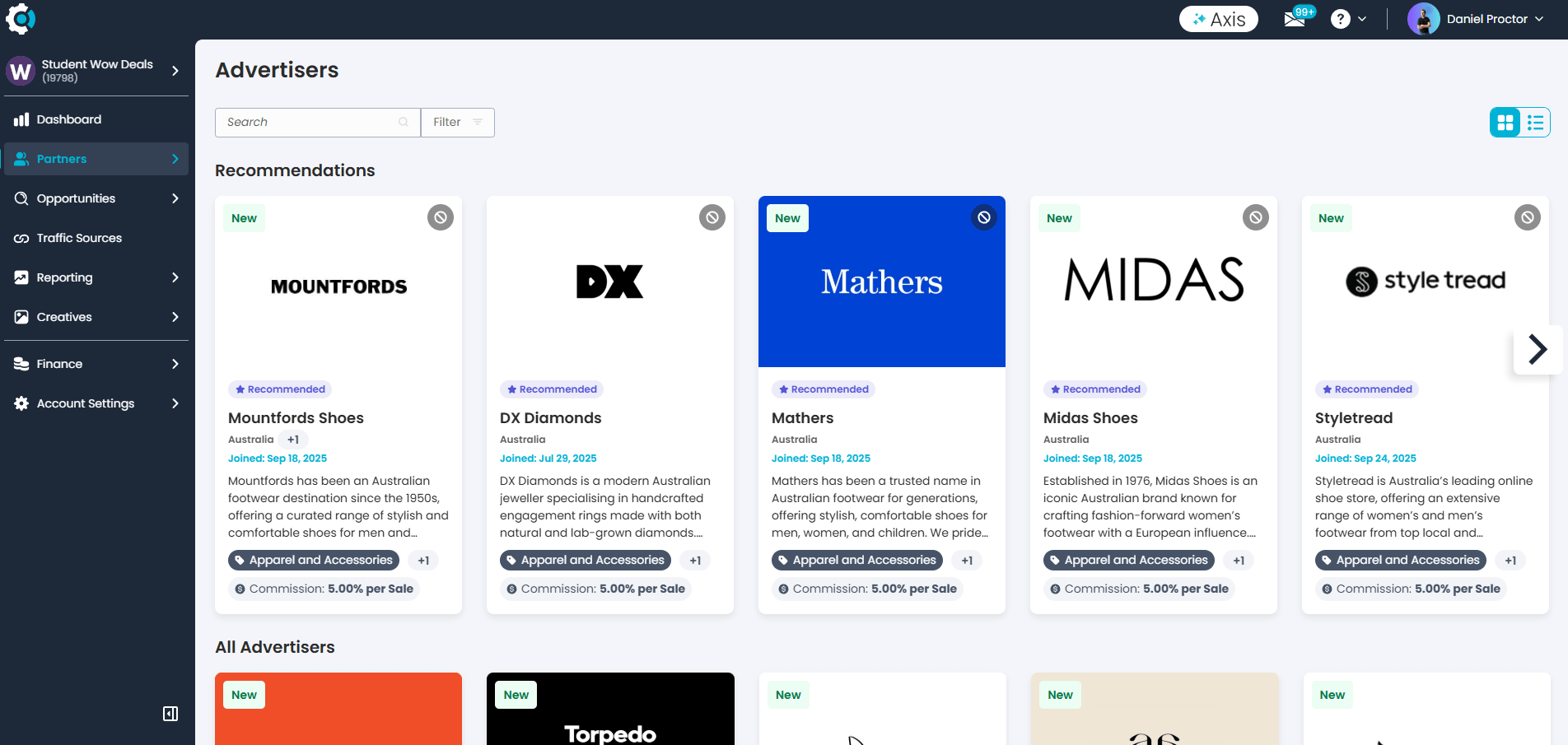
This Commission Factory affiliate network review wouldn’t be complete without a proper look under the hood—and that means spending time in the dashboard. This was actually the very first network I ever joined, and I’ve watched it grow and change over the past 10 years.
More importantly, it’s the platform where I first scaled my earnings into a six-figure annual income. A big part of that success came down to how straightforward and effective its tools are.
The whole platform feels designed to get you from A to B without any fuss. Finding advertisers, grabbing links, and checking your basic performance reports is all incredibly intuitive. You definitely don’t need a degree in data science to figure out your clicks, conversions, and commissions.
A Closer Look at the Affiliate Tools
Commission Factory gives you a solid set of tools to manage and tweak your campaigns. The real-time reporting is a huge plus, letting you see what’s working (and what’s not) almost immediately. You can also easily get your hands on promotional materials like banners, coupon codes, and deep links for specific product pages.
For those who like to get a bit more technical, the API allows for deeper integration. This is really handy if you’re building custom dashboards or trying to automate link creation. It’s where you can start building more complex and efficient systems for your affiliate business. You can check out more great resources in our guide to the best affiliate marketing tools out there.
A Balanced Look at Commission Factory’s Platform Tools
Even after a decade, I can see both the good and the bad in the platform. It’s always smart to have a balanced view before you dive in. So, here’s an honest look at what you can really expect from the tools on offer.
| Feature | Pros | Cons |
|---|---|---|
| Reporting Suite | Clean, real-time data that is easy for beginners to understand and use for daily tracking. | Lacks some of the advanced, granular filtering and segmentation found in larger global networks. |
| Link Generation | Extremely straightforward, with options for deep links, banners, and coupon codes readily available. | The process for creating multiple links at once can feel a bit manual compared to some competitors. |
| Promotional Assets | A wide variety of high-quality banners and creatives provided by major brands like Nike and The Body Shop. | Asset availability can be inconsistent for smaller or newer brands on the platform. |
| API Access | Provides the necessary functionality for custom solutions and automation, great for scaling publishers. | Documentation can be less comprehensive, posing a steeper learning curve for developers. |
While Commission Factory gives you great tracking tools, you still need to create compelling content to drive traffic. For many affiliates, learning how to create effective video ads has become a game-changer for promoting partner products.
Advanced Tracking in a Changing World
One of the biggest advantages of Commission Factory, especially since AWIN acquired them, is their investment in solid tracking technology. Let’s be honest, with privacy rules getting stricter and third-party cookies on their way out, accurate tracking is everything.
The platform uses server-side and first-party data solutions, which helps keep performance measurement accurate and protects your commissions. This focus on future-proofing its tech gives publishers like me the confidence that our hard work will actually get tracked and paid out correctly.
Key Takeaway: The Commission Factory platform really shines with its user-friendly design and solid core features. It might not have the most powerful analytics suite on the market, but its reliability, impressive list of brands, and modern tracking make it a fantastic tool for both new and seasoned affiliates. Its simplicity is often its biggest strength, letting you focus more on creating content and less on getting lost in complicated data.
How to Get Approved on Commission Factory
Getting into a top-tier network like Commission Factory is probably the first big hurdle you’ll hit as a publisher. This isn’t a platform for someone who just decided to start a blog yesterday. From my own experience over the last 10 years, I can tell you they’re looking for partners who are already up and running and ready to drive results.
This was the very first network I ever joined. Even back then, I knew I had to look like a serious publisher. The same goes for today. You have to show them you’ve already built something valuable—an audience, a brand, and a platform. Trying to apply with a half-baked website or a brand-new social media page is a surefire way to get rejected.
Is Commission Factory for Beginners?
So, is it a good network for beginners? The classic answer is “yes and no.”
If you’re a beginner who’s already put in the work—you have an active website with consistent traffic and a clear focus—then yes, Commission Factory is a great next step. The platform itself is actually pretty intuitive, so you’ll pick it up fast.
But, if you’re a complete beginner starting from absolute scratch with zero online presence, then no, this isn’t the place to start. You need to have something to show for your efforts first. Think of it like a job application: you wouldn’t show up with a blank resume, right? Same principle here.
The Four Pillars of a Successful Application
To get approved, you need to prove you’re a worthwhile partner. The good news is that Commission Factory’s criteria are pretty straightforward. If you nail these four key areas, you’ll dramatically boost your chances of getting in.
- Create a Professional Media Kit: This is a must. Your media kit is your affiliate marketing resume, plain and simple. It needs to professionally showcase your brand, break down your audience demographics, display your website traffic stats, and list your social media numbers. It signals to them that you’re running a business, not just a hobby.
- Have a Website with Existing Traffic: Commission Factory wants proof that you already have an audience. Your website needs to be live, look professional, and—most importantly—have a history of attracting visitors. They need to know you can send clicks to their advertisers right out of the gate.
- Define Your Niche Clearly: Vague “lifestyle” blogs are a dime a dozen. A strong application comes from a publisher with a super-defined niche. Whether you cover sustainable fashion, home gym equipment, or vegan cooking, a specific niche proves you have a targeted, engaged audience that advertisers want access to.
- Showcase High-Quality Content: The quality of your content is a direct reflection of your brand. Your blog posts, videos, or social posts have to be well-researched, well-written, and genuinely useful to your audience. This shows you can represent big brands like Nike and The Body Shop in a professional way.
A strong application isn’t just about filling out a form; it’s about presenting a compelling business case. You need to convince the network that approving you is a smart investment that will generate revenue for their advertisers.
Before you even think about hitting that apply button, take an honest look at your online presence. If you have these four pillars solidly in place, you’re not just applying—you’re positioning yourself as a valuable partner they’d be crazy to pass up. This is exactly the approach that got my foot in the door a decade ago and helped me build a six-figure income on their platform.
Exploring Top Brands and Earning Potential
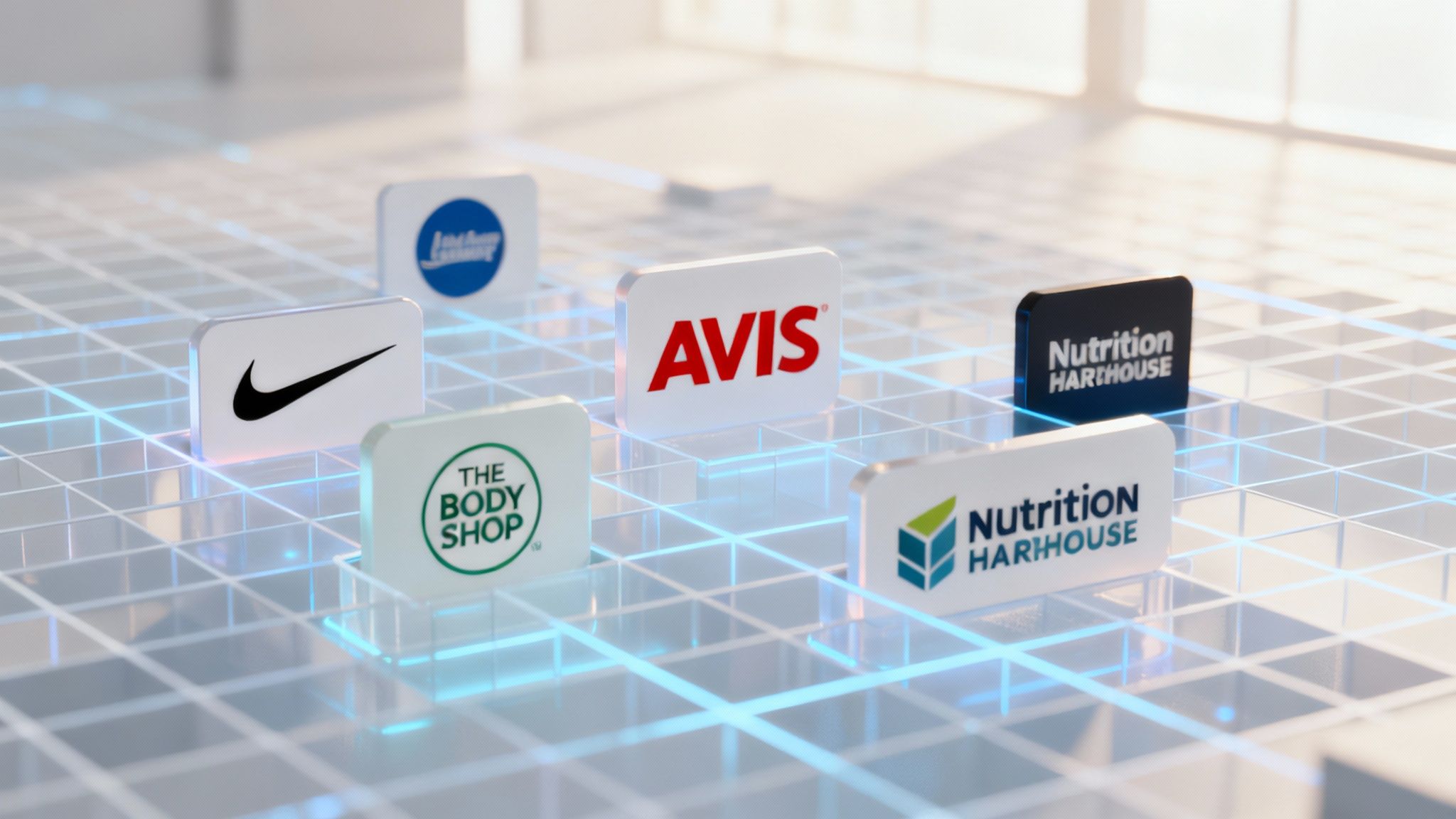
Let’s get to the good stuff—the brands you can actually work with and the money you can make. This is where the rubber meets the road for any affiliate network.
Honestly, one of the biggest reasons my own Commission Factory affiliate network review is so positive comes down to the quality and mix of advertisers they’ve brought on board. It isn’t just about having thousands of merchants; it’s about having the right ones.
You get access to global heavy-hitters like Nike and The Body Shop, but also a fantastic selection of beloved Australian brands like Shaver Shop, Nutrition Warehouse, and even Avis Car Rental. This kind of variety is gold. It means that whether your niche is fitness, beauty, travel, or tech, you’ll find reputable brands that actually make sense for your audience.
My Journey to a Six-Figure Income
Commission Factory was the first affiliate network I ever joined, and it’s where I started seeing my first real commissions roll in. More importantly, it was the first network where I broke the six-figure annual income mark.
That didn’t happen overnight, of course. It was a grind. It came from being selective about the brands I partnered with and really digging into the platform’s tools to see what was working.
My strategy was pretty simple, looking back. I zeroed in on a few high-performing brands that I knew my audience would love. I lived in the reporting dashboard, figuring out which products were converting, and then just created more content around them. This focused approach is what allowed me to scale up, proving the potential is absolutely real if you’re smart about it.
Understanding Your Earning Potential
Most offers on Commission Factory use a Cost Per Sale (CPS) model. In simple terms, you earn a cut every time someone clicks your unique link and buys something.
Commission rates are all over the place. You might see lower single-digit percentages on high-volume electronics, but then you’ll find rates of 15% or more for things like fashion or digital products.
It’s a numbers game, but a straightforward one. More traffic plus a good conversion rate equals more money. For example, if you’re pushing a product with a 10% commission and you drive 10 sales at $100 each, you’ve just made $100. The key is scaling that up with a solid content plan.
Finding good brands is only half the battle. Your real success hinges on getting eyeballs on your offers. Discover proven strategies to acquire organic traffic for your affiliate site.
Affiliate marketing has absolutely exploded. Today, over 80% of advertisers use it to find new customers, which shows just how powerful it’s become. Networks with big, trusted brands tend to do well because that consumer trust is already baked in, which helps explain why affiliate marketing now drives 16% of all ecommerce sales.
If you’re looking to see how Commission Factory stacks up against another major player, check out our Commission Junction (CJ) affiliate program review. It gives a detailed breakdown of a different (but equally powerful) network, which can help you decide where to focus your energy.
Common Questions About Commission Factory
My take on Commission Factory comes from being in the trenches with them for over a decade. It was the first affiliate network I ever joined, and it’s where I first cracked a six-figure annual income. I’ve seen it grow from a small startup on the Sunshine Coast to the biggest affiliate network in the Asia-Pacific.
That journey, which ended with them being bought by the global giant AWIN, gives me a pretty solid perspective on the questions that always seem to pop up when people are deciding whether to jump in.
Is Commission Factory Good for Beginners?
Yes and no. It really depends on what kind of “beginner” you are. If you’ve already got a website or a social media account with some real people visiting it, then yes, Commission Factory is a great choice. The platform is straightforward and you won’t get lost trying to figure things out.
But if you’re an absolute beginner starting from ground zero, it’s not the place to start. You need to have some kind of online presence and know your niche before you apply. Think of it as the perfect second step, right after you’ve built your foundation.
What Brands Are Available?
One of the best things about Commission Factory is the sheer number of brands they have on board. You’re looking at thousands of advertisers, from massive global players to well-loved local Aussie companies.
You’ll find big names you can partner with, like:
- Nike
- The Body Shop
- Shaver Shop
- Avis Car Rental
- Nutrition Warehouse
This mix means it doesn’t matter what your niche is—fashion, fitness, travel, tech, you name it. You’re almost guaranteed to find high-quality, reputable brands that your audience will actually be interested in.
How to Get Approved as an Affiliate
Getting approved isn’t a walk in the park. You need to look like a professional who can actually send sales to their merchants. Commission Factory wants to see that you’ve already done the hard yards building an audience and creating decent content.
The key is to present a strong business case. They aren’t just letting anyone in; they’re looking for genuine partners who will make their advertisers money.
Here’s what you absolutely need to have sorted before you even think about applying:
- Create a Media Kit: Put together a professional document showing off your brand, who your audience is, and your traffic stats.
- Have a Website with Traffic: You have to prove you have an active, established online presence that gets visitors.
- Define Your Niche Clearly: A focused content plan shows them you have a specific audience that advertisers want to get in front of.
- Produce Quality Content: Your work needs to be well-written and engaging. It’s your proof that you can represent brands without making them look bad.
Ready to stop guessing and start building an affiliate business that actually works? I offer a free masterclass that shows you the exact systems I’ve used to get where I am. Sign up today and get the clarity you need to start earning.

